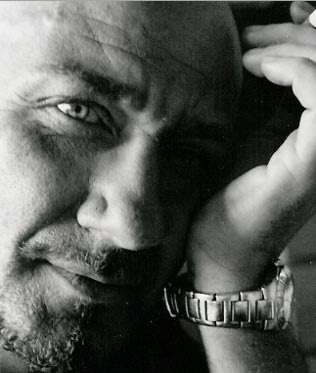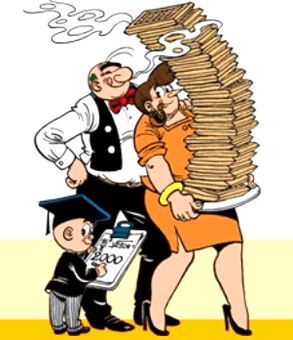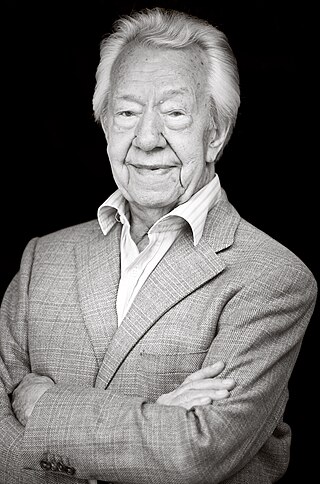Biography
Jan Bosschaert was born in Borgerhout in Flanders in 1957. [1] He was raised in Wijnegem, close to the forest, in a house with a large garden. [2] He spend most of his free time drawing. He made his first comic when he was about 10, and continued in the next years with comics in different genres, ranging from Sherlock Holmes stories to his own version of Lucky Luke . One of his comics, about two senior scouts, he shows to established comics creator Eddy Ryssack, whose main advice is to make sure everything is well documented. He also loved the work of André Franquin which he discovered at the age of 14 at a comics fair in Brussels. [2]
His puberty was a rather unhappy period, where Bosschaert withdrew into his own world and into music. He listened to artists like Tom Waits or Jackson Browne, but kept on drawing. When he was 18 years old, he visited comics author Pom. Seeing the poverty the author lived in was quite a shock, but it didn't stop him of becoming an artist himself. [2]
When he studied at the Sint-Lukasinstituut, the Art Academy of Brussels, he discovered the work of illustrator Ever Meulen, a former student of the same school, which greatly influenced him. Another great influence was Arzach , the textless comic by Moebius. Influences outside the world of comics came from the dominant styles of his youth, punk and new wave music. [1]
Bosschaert published his first work in (À Suivre), and produced his first published comic album in 1982 with Ikarus, but his breakthrough was the political-satirical comic strip Pest in 't Paleis (Pest in the Palace), which appeared in HUMO in 1983. But Bosschaert quit making comics and worked for the rest of the decade primarily as an illustrator for different magazines, including Playboy , and authors like Hugo Claus. His main illustrative work appeared first in publications of the Flemish television network VRT, and later in publications of publisher Altiora and popular children's book author Marc De Bel, whom he considers as a kindred spirit and an older brother. [2]
He also continued to make paintings, mainly female nudes and erotic works. Bosschaert is a purely figurative painter, who prefers clarity over concepts. [2]
His first longer running comic series started in 1990, with stories by Marc Legendre. Sam tells the adventures of an adolescent girl working in a small garage. The series came to a halt after 8 albums though, and translations were unsuccessful. While Bosschaert tried to limit his purely commercial work to a few jobs a year, he made an exception for people he feels connected to. He created King Kong Kooks as a catalogue annex comic for fashion designer Walter Van Beirendonck. [2]
More international recognition followed from 2001 on, when he collaborated with comics author Jean Dufaux on Jaguar , a fantasy series published by Casterman and translated in French and Spanish. Local success in Flanders came when he collaborates with comedian Urbanus on De Geverniste Vernepelingskes, a series which parodies famous Belgians, including the two authors. [1]
Bosschaert illustrated album covers for musical artists like The Paranoiacs, Pitti Polak, Plastic Bertrand and Jan De Wilde. [3]

Philippe Vandevelde, working under the pseudonym Tome, was a Belgian comics writer. He was known for collaborations with Janry on Spirou et Fantasio and Le Petit Spirou, and with Luc Warnant and later Bruno Gazzotti on Soda. He also collaborated with Ralph Meyer on Berceuse assassine, and with Marc Hardy on Feux. Earlier in his career he was an assistant-artist for Dupa.

The Adventures of Nero or Nero was a Belgian comic strip drawn by Marc Sleen and the name of its main character. The original title ranged from De Avonturen van Detectief Van Zwam in 1947 to De Avonturen van Nero en zijn Hoed in 1950, and finally De Avonturen van Nero & Co from 1951. It ran in continuous syndication until 2002. From 1947 until 1993 it was all drawn by Sleen himself. From 1992 until 2002 Dirk Stallaert took over the drawing while Sleen kept inventing the stories.

Marcel Honoree Nestor (ridder) Neels, known as Marc Sleen, was a Belgian cartoonist. He was mostly known for his comic The Adventures of Nero and Co., but also created gag comics like Piet Fluwijn en Bolleke, De Lustige Kapoentjes, Doris Dobbel, Oktaaf Keunink and De Ronde van Frankrijk.

Joseph Gillain, better known by his pen name Jijé, was a Belgian comics artist, best known for being a seminal artist on the Spirou et Fantasio strip and the creator of one of the first major European western strips, Jerry Spring.

Willebrord Jan Frans Maria "Willy" Vandersteen was a Belgian creator of comic books. In a career spanning 50 years, he created a large studio and published more than 1,000 comic albums in over 25 series, selling more than 200 million copies worldwide.

Urbain Servranckx, better known as Urbanus, is a Belgian comedian, actor, singer and comic book writer. Although he is most famous as comedian, some of his songs became hits, such as Bakske vol met stro (1979), Madammen met een bontjas (1980) and Hittentit (1982). He is one of the most popular and famous entertainers in Flanders and the Netherlands.

William van Cutsem, better known by his pen name William Vance, was a Belgian comics artist known for his distinctive realistic style and work in Franco-Belgian comics.

Belgian comics are a distinct subgroup in the comics history, and played a major role in the development of European comics, alongside France with whom they share a long common history. While the comics in the two major language groups and regions of Belgium each have clearly distinct characteristics, they are constantly influencing one another, and meeting each other in Brussels and in the bilingual publication tradition of the major editors. As one of the few arts where Belgium has had an international and enduring impact in the 20th century, comics are known to be "an integral part of Belgian culture".

Jozef "Jef" Nys was a Belgian comic book creator. He was best known for his comic strip Jommeke.
Edouard Paape, commonly known as Eddy Paape, was a Belgian comics artist best known for illustrating the series Luc Orient.
Dutch comics are comics made in the Netherlands. In Dutch the most common designation for the whole art form is "strip", whereas the word "comic" is used for the (usually) soft cover American style comic book format and its derivatives, typically containing translated US superhero material. This use in colloquial Dutch of the adopted English word for that format can cause confusion in English language texts.
Arthur Berckmans, better known as Berck, was a Belgian comics author, best known for Sammy.
Luc Cromheecke, is a Belgian comics artist best known for the comic series Tom Carbon, Taco Zip, Roboboy and Plunk.
Gilbert Declercq is a Belgian freelance painter, illustrator, and comics artist.
René Follet, sometimes known by the pen name Ref, was a Belgian illustrator, comics writer and artist.

Frank Pé, often signing solely as Frank is a Belgian comic book artist, best known for Broussaille and Zoo.
Renaat Bosschaert (1938–2006) was a Belgian artist working in painting, graphic arts, sculpture, ceramic arts, engraving and printmaking.
Renaat Demoen was a Belgian illustrator and comics creator. He is most associated with the children's magazines of De Goede Pers, among them Zonneland.

Maurice De Bevere, better known as Morris, was a Belgian comics artist, illustrator and the creator of Lucky Luke, a bestselling comic series about a gunslinger in the American Wild West. He was inspired by the adventures of the historic Dalton Gang and other outlaws. It was a bestselling series for more than 50 years that was translated into 23 languages and published internationally. He collaborated for two decades with French writer René Goscinny on the series. Morris's pen name is an Anglicized version of his first name.

Suske en Wiske Weekblad was a Belgian comics magazine which debuted in September 15, 1993 and ran in weekly syndication until December 24, 2003. It was based on the popularity of Suske en Wiske and notable for being the last attempt in Flanders to release a new comic book magazine.












